Melasma: Why do age spots appear on the face?
As the number of sunny days increases, Sharper raises the question of protecting the skin from ultraviolet radiation. In addition to malignant skin tumors and photo-aging, it can cause brown or blue-gray spots on the face, called melasma. Most often it occurs in women of twenty to fifty years old, and the probability of melasma is increased by genetic predisposition and hormonal changes. We understand what kind of condition.
Text: Vera Voronina, Candidate of Medical Sciences, dermatologist at the Rassvet clinic

What is melasma
Melasma is a condition in which dark spots with clear boundaries appear on the skin. Physical well-being is not disturbed, but due to changes in the appearance of the skin, emotional perception of oneself can suffer - and with it the quality of life. Melasma spots may be brown or slate gray. Most often they appear in the central area of the face (on the back of the nose, forehead, cheekbones and upper lip) and along the line of the lower jaw, but can also occur in other places especially exposed to sun exposure: forearms, shoulders, and décolleté.
In case of melasma, an increased deposition of melanin pigment occurs, and this can occur in different layers of the skin and at different depths - the visible color of the spots depends on it. With superficial deposition, when melanin is located between the cells of the epidermis or inside the keratinocytes, the spots look brown, and the deeper (dermal) deposition leads to gray-blue, slate-gray, gray-brown spots. In this form, melanin is found in the cells of melanophages - they absorb it in more superficial layers, and then migrate deep into. Most often, the pigment is deposited simultaneously in different layers and melasma is mixed.
Hormones and sun
The main reason for the appearance of spots is ultraviolet radiation: for most people with melasma, daily or occasional exposure to the sun is characteristic. As a rule, the pigmentation increases during the months of intense solar radiation, and in winter it may decrease or even disappear. Melasma is more susceptible to people with a dark skin tone.
Another important factor is hormones, in particular, elevated levels of estrogen, progesterone and melanocyte-stimulating hormone. Due to endocrine changes, pigment spots often appear during pregnancy - another term, chloasma, is used to designate them. Enhanced pigmentation is so common in this period that before it was even called the "mask of pregnancy." Hormonal contraception or hormone replacement therapy during menopause can also contribute to the appearance of pigment spots.
Melasma is much less common in men - according to the American Academy of Dermatology, they account for 10% of cases; however, the relationship with the hormonal background in men is not very clear. Irritant cosmetics (for example, gommazhi or peelings) may contribute to the appearance of pigment spots, and hereditary predisposition may also be important. So, if a person wants to avoid the appearance of spots, you need to carry out prevention - to protect the skin from ultraviolet radiation and to remember the risk of pigmentation when taking oral contraceptives and hormone replacement therapy.

Prevention and adjustment
Protecting the skin from ultraviolet radiation remains the main measure for preventing skin cancer and melanoma, and it also helps prevent melasma and reduce (or even eliminate) the pigmentation that has already appeared. Of course, melasma is not a disease, and it is not necessary to treat it; the more so since it is a chronic and recurring condition, and perhaps the result will not be worth the effort. But if the spots are upsetting, something can be done.
The most important thing for reducing existing foci and preventing new ones is protection against ultraviolet rays, including wide-brimmed hats and sunscreens. It is important to avoid direct sunlight, do not sunbathe and do not go to the solarium. The cream must provide protection from spectrum A rays (depending on the country, the broad spectrum label is used or the asterisks indicate the degree of protection against ultraviolet spectrum A) and spectrum B (marked with an SPF value, use of SPF 30 and higher is recommended for patients with melasma ). Photoprotective cream should be applied before going out, and then updated every two hours. Cream should be enough - for the face, ears and neck is 5 ml (one teaspoon) of funds. The use of photoprotection during pregnancy can effectively prevent the occurrence of pigmentation.
Melasma can disappear on its own - most often this occurs when pigmentation is associated with pregnancy or hormonal intake. Melasma due to pregnancy usually regresses within a year after giving birth, but some foci may never completely disappear.
Other means
Sometimes photoprotection is enough to foci disappear - but this is not always the case. Creams containing 2% hydroquinone are most commonly used to lighten pigmentation spots. This substance reduces brown staining by affecting the enzyme tyrosinase, which is necessary for the synthesis of melanin in cells. Means with hydroquinone are usually applied to the pigmentation sites twice a day - in this case, a photoprotective cream must be applied on top (sometimes photoprotection factor is included in the product with hydroquinone). Hydroquinone is effective in all types of melasma, but works best with superficial (epidermal) deposition of melanin.
One method, effective for all patients with melasma, has not yet been found, so usually doctors combine methods and drugs, especially with recurrent pigmentation. In addition to hydroquinone, azelaic acid at a concentration of 15-20%, retinoic acid (tretinoin) at a concentration of 0.025-0.1%, koi, lactic, glycolic acid are used; The doctor may prescribe a small dose of corticosteroids. If all this is not enough, you can try cosmetic procedures: lasers and chemical peels.
It is worth remembering the risks of "treating" melasma and reasonably assessing them - it is possible that taking pigment spots would be a more careful decision regarding your health than trying to get rid of them. It is important to remember that with prolonged use of hydroquinone, especially in high concentrations (4% and above), so-called exogenous ocronosis may develop - specific persistent changes in skin color. This is a frequent occurrence in regions where people with ethnically dark skin use high concentrations of the substance in an attempt to lighten it - 10% or even 20%. In addition, active components for the correction of pigmentation often irritate the skin.
Meanwhile, research is underway on new products: for example, the efficacy of tranexamic acid was noted when injected into the nidus of pigmentation or when applied externally, there are positive data on the external use of rocinol. However, the mechanisms of the effect of these substances on pigmentation are not yet very clear, and the drugs themselves are not registered to treat skin hyperpigmentation.
PHOTO:sbgoodwin - stock.adobe.com, dule964 - stock.adobe.com





